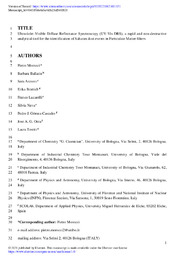Título :
Ultraviolet–Visible Diffuse Reflectance Spectroscopy (UV–Vis DRS), a rapid and non-destructive analytical tool for the identification of Saharan dust events in particulate matter filters |
Autor :
Morozzi, Pietro 
Ballarin, Barbara 
Arcozzi, Sara
Brattich, Erika
Lucarelli, Franco 
Nava, Silvia 
Gómez-Cascales, Pedro José
Garcia Orza, Jose Antonio 
Tositti, Laura |
Editor :
Elsevier |
Departamento:
Departamentos de la UMH::Física Aplicada |
Fecha de publicación:
2021 |
URI :
https://hdl.handle.net/11000/35188 |
Resumen :
Mineral dust represents one of the main components of particulate matter (PM) in the Mediterranean area. The rapid identification of Saharan dust events in PM samples is desirable and required for several reasons, including their role in direct effect on climate by radiative forcing as well as their adverse effects on human health. For this purpose, the feasibility of UV–Vis Diffuse Reflectance Spectroscopy (UV–Vis DRS) is described as a rapid, inexpensive and non-destructive method of analysis of PM filters. The method developed allows to parameterize the PM filter colors and to obtain semiquantitative data related to iron oxide minerals, mainly hematite and goethite, two of the most representative minerals of Saharan dust in the Mediterranean area. The obtained results were validated based on the correlation between the spectrophotometric data of iron oxides from the membranes with the quantitative assessment of the concentration of iron by Particle Induced X-ray Emission (PIXE). Moreover, colorimetric parameterization allows setting up a classification approach for filters with potential for a posteriori use of this data in the study of the optical behavior of aerosol particles in the air. In this work, it is demonstrated how, as the concentration of iron mineral oxides and especially of hematite increases, the extent of redness color in PM filters grows up. Therefore, this technique can be extremely useful for a rapid, cheap and unambiguous identification of Saharan dust events in PM filters. The diagnosis of Saharan dust events was performed on PM10 filters with a strong mineral dust component and demonstrated with the residence time analysis of back-trajectory ensembles, proving the reliability of this non-destructive methodology. This method has the potential to be adopted by the Environmental Protection Agencies, although further evaluations are necessary and currently underway to assess their applicability not only for PM filters sampled in remote stations but also in urban stations affected by both anthropogenic pollution and Saharan dust events.
|
Palabras clave/Materias:
Saharan dust
Diffuse reflectance spectroscopy
Iron oxide minerals
Colorimetry
Chemometrics
Residence time analysis |
Área de conocimiento :
CDU: Ciencias puras y naturales: Física |
Tipo de documento :
info:eu-repo/semantics/article |
Derechos de acceso:
info:eu-repo/semantics/openAccess
Attribution-NonCommercial-NoDerivatives 4.0 Internacional |
DOI :
https://doi.org/10.1016/j.atmosenv.2021.118297 |
Publicado en:
Atmospheric Environment |
Aparece en las colecciones:
Artículos - Física Aplicada
|

 La licencia se describe como: Atribución-NonComercial-NoDerivada 4.0 Internacional.
La licencia se describe como: Atribución-NonComercial-NoDerivada 4.0 Internacional.
.png)